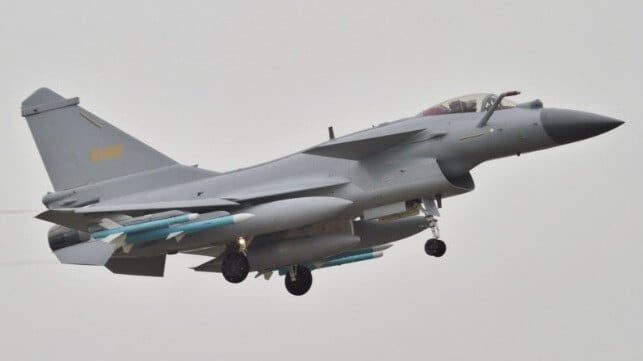Chinese Fighter Launches Flares in Front of Australian Navy Helicopter

This week, the government of Australia took the Chinese military to task for another "unprofessional" encounter involving a People's Liberation Army fighter aircraft. The intercept was potentially more hazardous than the close-approach tactics seen in dozens of previous encounters: a Chinese jet flew just in front of a Royal Australian Navy helicopter and dispensed flares, forcing the helicopter pilot to maneuver quickly to avoid being hit.
On May 4, the frigate HMAS Hobart was in international waters of the Yellow Sea, conducting an enforcement patrol in support of UN sanctions against North Korea, according to Australian officials. A Royal Australian Navy MH-60R helicopter from HMAS Hobart was intercepted by a People's Liberation Army Air Force J-10 fighter jet. The aircraft passed about 1,000 feet ahead of the helicopter's flight path and 200 feet above it, then released decoy flares, Australian officials said. The helicopter had to take evasive action to avoid a potentially hazardous interaction with the flares. Australia's defense ministry called it an "unsafe maneuver" that created risk for the aircrew.
"This isn’t normal by any stretch of the imagination," defense expert and former Royal Australian Navy officer Jennifer Parker told ABC. "Impeding its flight path I would interpret as a breach of international law."
The Australian government protested the encounter in strong terms. "We’ve just made it very clear to China that this is unprofessional and that it’s unacceptable," Prime Minister Anthony Albanese told Nine News earlier this week.
In response, China's ministry of defense accused the Royal Australian Navy of "close-in reconnaissance and disturbance" of a Chinese military exercise. "We firmly oppose the Australian side’s statement confusing black and white and making unfounded countercharges," spokesman Zhang Xiaogang said in a statement.
Albanese refused to accept this accusation, and said that the interaction occurred in international airspace - as China has confirmed.
This is far from the first run-in that Western forces have had with Chinese fighter pilots. An Australian helicopter pilot described a nearly identical encounter involving flares in an interview with CNN in 2023.
In another similar incident in 2022, a Chinese jet released bundles of aluminum chaff into the flight path of an Australian P-8 surveillance plane near the Paracel Islands, a contested archipelago where China has built a string of military bases. One of the P-8's engines ingested the aluminum strips, which can damage turbine blades or force an engine shutdown. The aircraft made it safely back to base. At the time, Chinese defense ministry spokesman Tan Kefei called the interaction "professional, safe, reasonable and legal."
